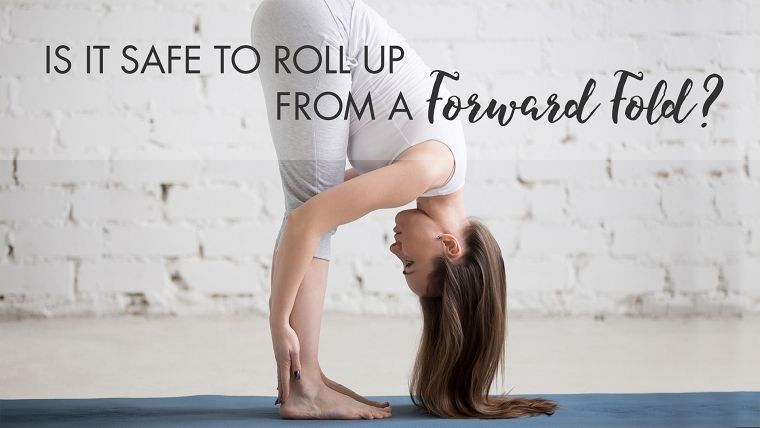Is it safe to roll up from a forward fold?

Imagine you’re in the mood to reorganize your furniture. You grab one end of the sofa, and you watch as your partner grabs the other end and lifts with locked knees and a rounded lower back. “Bend your knees! Lift with your legs!” you implore. “Protect your lower back!” You don’t want your furniture mission to be the cause of later pain for your partner (plus you don’t want to be the icepack-bearer for the next few days). Yet, when the teacher in your yoga class or video asks you to roll up “one vertebra at a time,” you do it without question.
Many yoga teachers (myself included) once believed that “rolling up” was a gentler way of coming back to standing from uttanasana (standing forward bend)—but the lumbar spine, or lower back, doesn’t think so.
Here’s what happens when you roll up. Your ragdoll upper body is actually pretty heavy (think 50 to 75 pounds for a 150-pound person). Not as heavy as the sofa, of course, but still a good amount of passive weight dangling on the lumbar spine and sacroiliac (SI) joints, if your legs are straight. Then, without abdominal support, you use your back muscles to drag your body up to tadasana (mountain pose)—much like the unsupported couch lift mentioned above.
This move compresses the anterior lumbar discs, sometimes several times in one practice, with our bodies unfurling like those dancing, attention-getting, air-noodle guys in car lots. The noodle guys are fortunate in not having to worry about spines, while we vertebrates need to be smart—since ruptured and degenerative discs are not what we want in our future.
There are two ways to avoid both discs squishing and stressing of the SI joints when we come up to standing from a forward bend:
- As if you were lifting a couch, bend your knees and use your legs, gluteals, and core to come to a standing position. Even if your back is slightly rounded, this move is easier on your back and will be less distinguishable from what the rest of the class is doing (meaning you’re not going to stand out if you do this when your yoga teacher asks you to roll up). It’s not as beneficial, however, as coming up with a “flat back” (see example 2).
- Soften your knees (or bend them a lot if your hamstrings are tight), bringing your arms out wide and coming to a stand with a “flat back.” The back we are looking for is not actually flat, because your spine itself isn’t flat. As you come up, you keep your spine long rather than rounded, while maintaining the natural shape of your spine. For more of a challenge, you can extend the arms forward. This strengthens the area of concern rather than putting it at risk.
Not all convex movements of the spine are bad. Rounding is a natural movement of the spine. Some good examples of healthy, rounded lumbar postures include balasana (child’s pose), marjaiasana (cat pose), apanasana (knees to chest pose), and bakasana (crow pose). Gravity is what causes a problem in the standing roll-up. A non-standing pose that can cause similar lumbar disc compression is paschimottanasana (seated forward fold)—often practiced from dandasana (staff pose), with a lower back that’s already rounded, and then bending from the waist (as opposed to hinging from the hips). In this already non-optimal position, if you then pull on your feet with a strap or your hands, you effectively add even more weight down upon that rounded lower back. The solution here is to either (once again) bend your knees, or angle the pelvis with a blanket for support. Oh, and by the way, a rounded halasana (plow pose) can also cause the cushions between the vertebra to be excessively squeezed. (And we thought it was just the neck we had to worry about with that one!) One solution is to support the shoulders on a couple of folded blankets—aligning the hips directly above the shoulders, avoiding flattening the cervical curve, and engaging the core to maintain the lumbar curve.
The key to a safe, sustainable yoga practice is in learning more about how the amazing spine works, and in moving in informed ways so that our backs remain pain-free for a long, happy lifetime.
Recent Comments